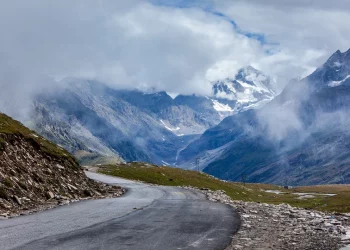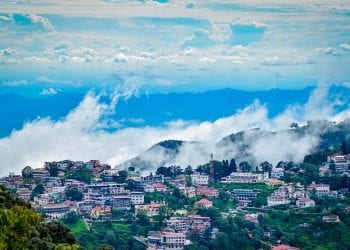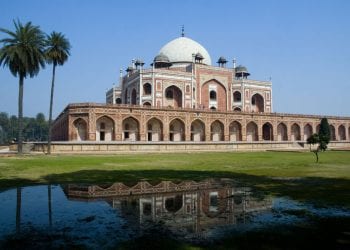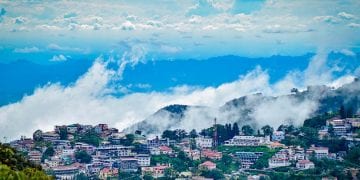10 Amazing Temples in Mysore to Visit on Your Next Trip
Mysore, also popularly known as Mysuru, is a land of rich historical and cultural heritage. It was home to the legendary Tipu Sultan and Hyder Ali. Given its royal past, Mysore houses magnificent palaces, gardens, ancient temples and monuments, making it one of the most popular cities to visit in South India. And if you are spiritually inclined, you cannot miss the religious sites in this beautiful city. Do temples and old ancient architecture intrigue your spiritual soul? Then you are in the right place.
Top 10 Temples To Visit In Mysuru
- Chamundeshwari Temple
- Nandi Statue
- Gayatri Temple
- Someswara Temple
- Bhuvaneshwari temple
- Bylakuppe Buddhist Golden Temple
- Shreekanteshwara Temple
- Shweta Varahaswamy temple
- ISKCON Temple
- Talakad Temples
1. Chamundeshwari Temple
The most striking feature of the Chamundeshwari temple is its intricate and ornate architectural style and carvings, reflecting the profoundly artistic culture of Mysore. This iconic temple is one of the major religious sites and is situated at the top of the Chamundi Hills and is one of the oldest and revered sacred places to visit. The date of construction of the temple is disputed, but it is popularly said to have been built in the 12th century. One of the greatest attractions of this temple is a statue of Nandi which can be witnessed after climbing 1000 feet. The figure of Nandi was built later in the 17th century. The entire temple complex has marvellous carvings all over the exterior and interior walls as well as the roof and pillars. A number of stone carved statues add to the aesthetic beauty of the place.
2. Nandi Statue
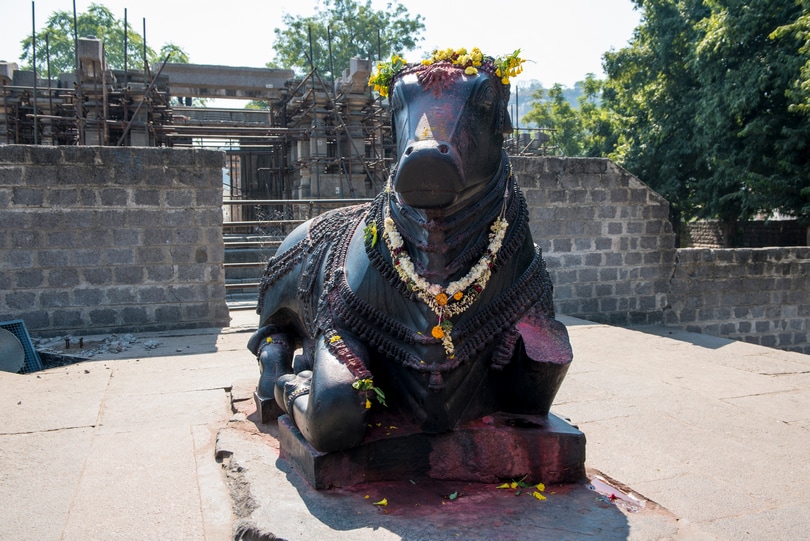
The Nandi statue is another one of the best religious sites in Mysore and is believed to have been constructed from a large but single rock. The idol is dedicated to the worship of Lord Shiva’s mount, Nandi. Locals commonly refer to it as the Bull temple, and it is nestled thousands of feet atop the Chamundi Hills and is more than 100 years old. The gorgeous bull is carved entirely of black stone and adorned with intricately carved jewellery hanging from his neck. It was commissioned by the Dodda Devaraja Wodeyar. The Bull’s temple in Mysore houses the third largest and most significant Nandi idol in the country.
3. Gayatri Temple
The Gayatri temple in Mysore is a testimony to the city’s royal heritage, and the temple was constructed by the famous and last ruler of Mysore, Maharaja Jayachamaraja Wodeyar in the year of 1953. The Maharaja himself commissioned the most gifted sculptor of his times to carve and instate the idols. Inside the temple are the idols of the deities Shiva, Vishnu, and Ganesha. The temple is dedicated to the worship of Goddess Devi and houses three more shrines inside the complex such as the Savitri, Gayatri, and Lakshmi shrines. It is one of the most interesting religious sites in Mysore.
4. Someswara temple
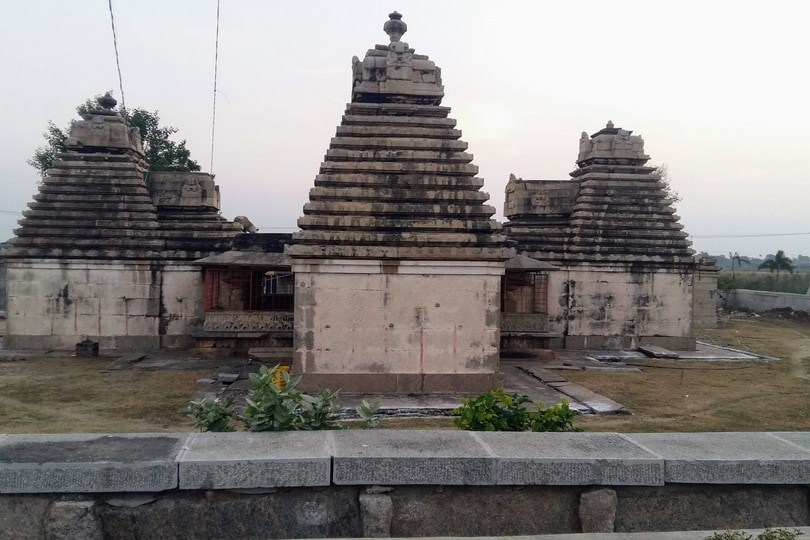
A magnificent treat to the eyes and also one of the most visited religious sites in Mysore is the temple of Someswara. It was constructed in the 13th century by the Wodeyar Dynasty. Someswara temple used to serve as the significant place of worship and celebrations for the Wodeyar rulers and hence it has a marvellous regal facade. Due to its direct association with the city’s royal past, the architecture is suited to meet the royal taste. The temple houses three shrines dedicated to Lord Shiva, Narayana, and Goddess Somasundari. The Shiva linga is believed to be centuries old. One of the best times to visit this temple is during Shiva Ratri or Dusshera when the temple is decked up and devotees celebrate these religious Hindu festivals with great vigour.
5. Bhuvaneshwari Temple
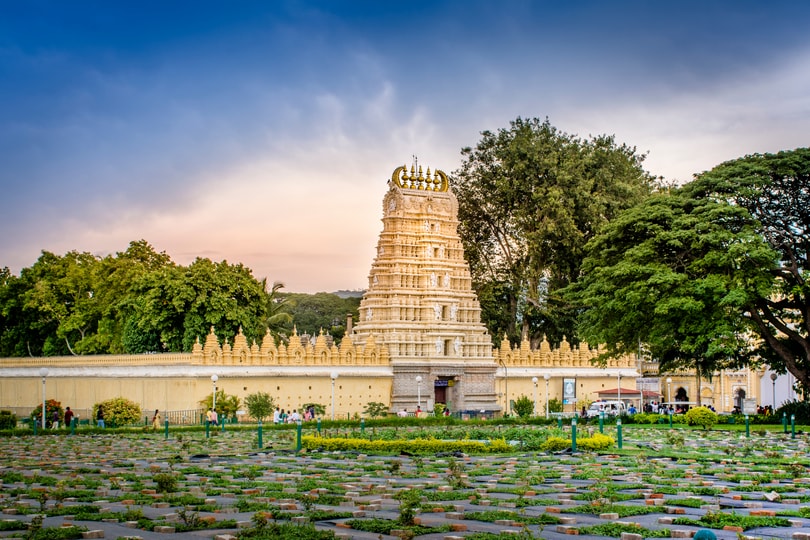
Bhuvaneshwari temple was built in the 1950s and is dedicated to Goddess Bhuvaneshwari. The temple follows the traditional Dravidian style of temple architecture prevailing in South India. One of the prime attractions of this site is the high rising Surya Mandala, an ornate gate with unparalleled intricate sculptures. This Mandala was gifted to the temple by the ruler Jayachamaraja Wodeyar and is constructed out of pure copper. A special prayer is performed at the Surya Mandala every year in the first two months. This is one of the festivities attracting tourists and locals alike to Bhuvaneshwari temple.
6. Bylakuppe Buddhist Golden Temple
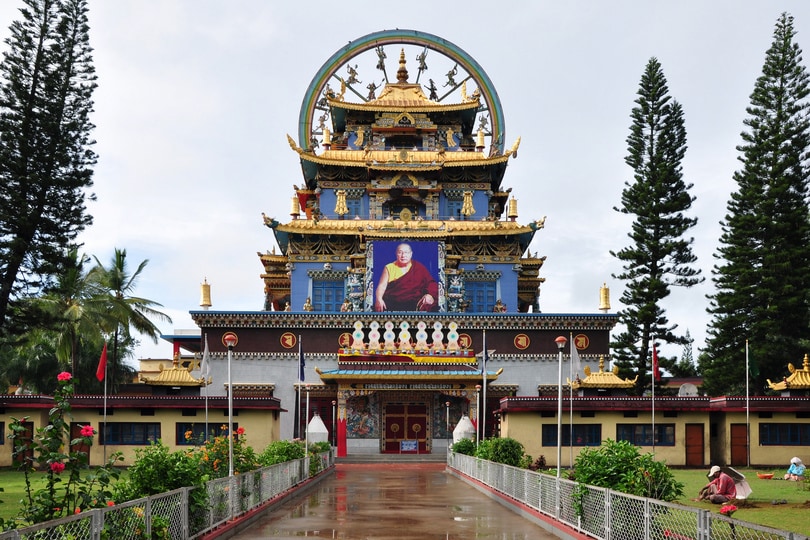
Close to Mysore is the tranquil Tibetan-Buddhist settlement known as Bylakuppe, established by the Tibetan community who migrated to India. The settlement was built in the year 1961 and has been home to the Vajrayana Buddhist monks for a long time. It is one of the most serene religious sites you will come across. The Golden Temple of the Tibetans is a sanctuary where religious knowledge is imparted and rituals are held. The Golden temple is also one of the most significant learning centres of Tibetan Buddhism- its origin, beliefs, and practices offering curious travellers the right insight into the unique culture. The Golden temple sees maximum footfall during the major Tibetan festivals, attracting tourists and locals alike with an auspicious vibe. The very architecture of the temple is a refreshing treat to the eyes as it appears to be straight out of a movie set. The small homes feature tiled roofs surrounded by meandering roads. The way to the monastery is dotted with colourful prayer flags tethered onto lamp posts. Although remote and majorly unexplored, you can reach the Bylakuppe settlement easily by road.
7. Shreekanteshwara Temple
The Shreekanteshwara temple, popularly known as Nanjundeswara temple is one of the most famous religious sites located in Nanjangud, a small unspoiled town situated 25 km from Mysore city, located on the banks of the river Kapila. The very place Nanjangud derives its name from the temple of Nanjundeswara which was built by the highly revered Nanjundeswara Swami. The town is also called “Dakshina Kashi” or the Kashi of South. Tourists also know this place as the Varanasi of the South. The temple is dedicated to the worship of Lord Shreekanteshwara who is an incarnation of Shiva. The architecture of this temple follows the archetypal Dravidian style of temple architecture. The temple is a popular tourist destination, owing to the legends surrounding its foundation. Popularly, it is believed that Saint Gautama himself instated the Shiva Linga in the temple. The Shreekanteshwara temple is vast, spreading over an area of one acre, and houses one hundred and twenty-one deity idols of all of Shiva’s incarnations, along with sixty-five Shiva Lingams. You will be mesmerized by the gorgeous ancient Sala towers over large pillared mandapas, and decorative old pillars. The temple witnesses maximum footfall during the “Dodda Jaathre”, a 3-day festival held every year by the end of March. The festivities involve a street procession of colourful chariots that are pulled by devotees, and thousands flock to witness the holy ‘yatra.’ The path designated for the chariots to proceed is special and referred to as the ‘Ratha beedi.’
8. Shweta Varahaswamy Temple
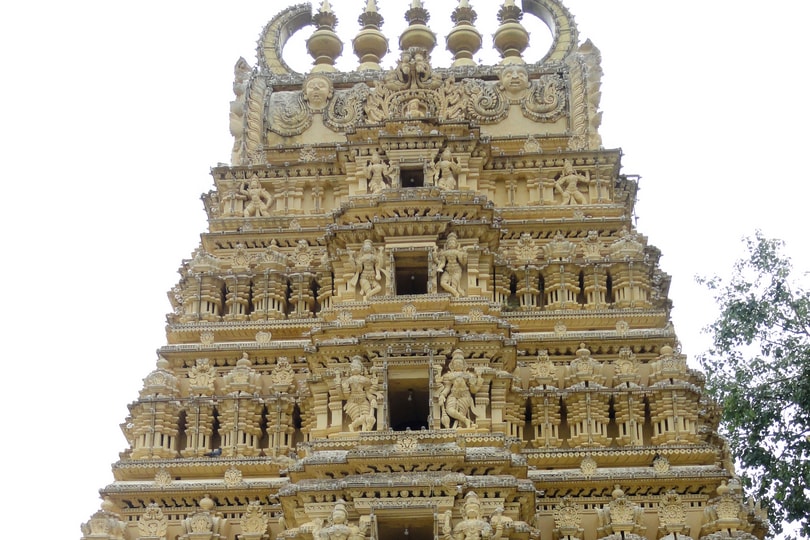
One of the most famous temples visited by tourists is the Shweta Varahaswamy temple which sits near Mysore fort, within the premises of the Mysore Palace. The temple is dedicated to the worship of Lord Varaha, an incarnation of Lord Vishnu. The greatest attraction of this temple is the figurine of Shweta Varahaswamy, carved intricately out of stones. The walls of the temple are adorned with unique carvings, narrating the tales from Mahabharata on the pillars, doorways, and walls. The architecture of the temple is beautiful and ancient, following the Hoysala style of architecture.
9. ISKCON
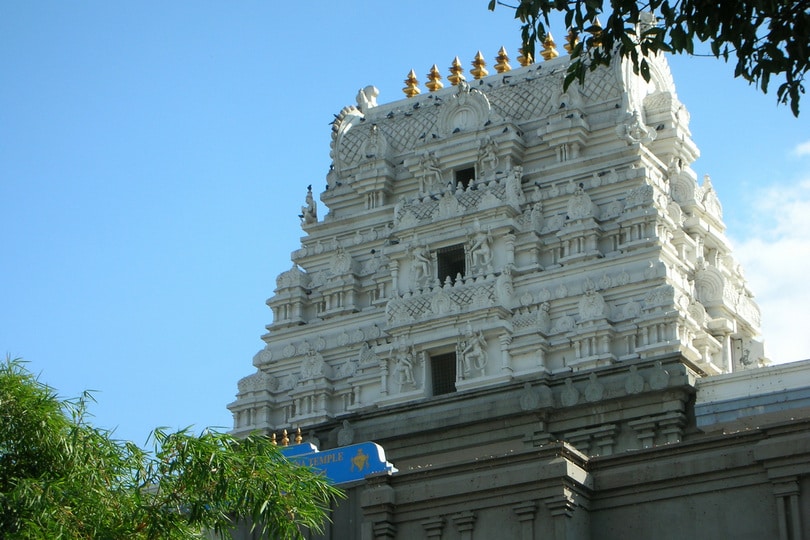
ISKCON or The International Society for Krishna’s Consciousness is one of the most celebrated religious sites in India, and one such is also based in Mysore, dedicated to Lord Krishna and the saintly Radha. People visit the temple mostly to enjoy a tranquil yet energetic time as they host prayers, kirtan, and myriad rituals on a daily basis. If you visit on a Sunday, you will be treated to some delicious Prasad. You can visit and just soak in the peaceful atmosphere, or attend the cultural and spiritual discourses offered by ISKCON. ISKCON appears at its best during festivals such as Janmashtami, Holi, Ekadashi, Gaur Purnima, and Radha Ashtami.
10. Talakad Temples
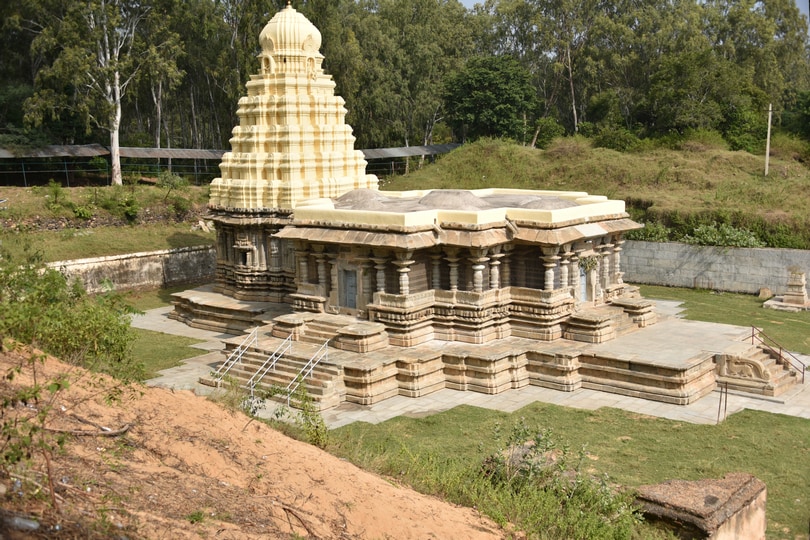
Among the most visited religious sites in Mysore are the ancient Talakad temples. This group of temples dates back to the times of the Ganga and the Woedyar dynasties. It is 45 km from the city of Mysore and can be easily accessed by road transportation. The temples are associated with many beliefs as to how they were constructed by the rulers of Southern India. Most of them are now in ruins and are believed to be cursed. The site used to witness sand rising every year when the entire Talakad would get submerged under the sands, along with the temples. These temples remained undiscovered for a long time until the 20th century, after which they were excavated. The premise houses five incarnations of Lord Shiva, and they are still significant sites of mythology, legend, and folklore. So, are you all set to explore the rich culture, heritage and traditions of Mysore by visiting its temples? Then book your accommodation in advance and plan a trip during winter months, so that the vacation is comfortable.
P.s. You might like these related resources:
- Bundle of Joy and City of Palaces – Mysore
- The best places to visit in Mysore for a holistic experience
- Weekend Getaways from Mysore you better not miss!
Recent Posts
Top Picks

- OYO
 15 April, 2024
15 April, 2024 - Cultural Tour

- OYO
 15 April, 2024
15 April, 2024 - Cultural Tour

- OYO
 15 April, 2024
15 April, 2024 - Cultural Tour

- OYO
 15 April, 2024
15 April, 2024 - Cultural Tour

- OYO
 15 April, 2024
15 April, 2024 - Cultural Tour

Please rotate your device
Please go back to portrait mode for the best experience




 April 15, 2024
April 15, 2024 